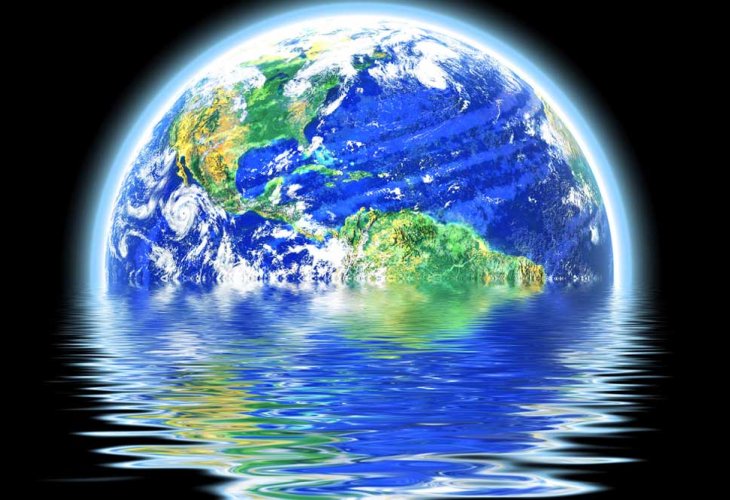In Search of God
Where Did the Floodwaters Go? The Science and Faith Behind the Global Deluge
Exploring tectonic shifts, tsunamis, and cosmic forces — how geology and ancient texts align in explaining the Flood and the mystery of the vanished waters
 (Photo: Shutterstock)
(Photo: Shutterstock)Yoni asks: “I understand that the waters covered even the mountaintops, including Mount Everest, which rises nine kilometers above current sea level. That’s an unimaginable amount of water. Where did it all go when the Flood ended?”
* * *
This question has intrigued scientists, theologians, and curious minds for generations — how could so much water appear and then disappear?
Global Evidence for a Flood
In a previous article, we explored evidence for a worldwide flood — including mass extinctions of animals across continents and the discovery of marine fossils (shells, corals, crabs, and fish skeletons) found not only in deserts like the Sahara but even on mountaintops such as the Rockies and the Himalayas.
These findings suggest that vast areas once lay beneath the sea. The question becomes: where did all this water come from, and where did it go?
The Structure of the Earth and the Mystery Beneath
A look at the Earth’s internal structure offers important clues. The Earth’s crust is made up of nine giant tectonic plates that float on a molten, viscous layer known as the mantle. These plates fit together like puzzle pieces — forming the solid surface of the continents and ocean floors.
Because they rest on fluid rock, the plates move slowly and collide over time. Even minor friction between them can trigger earthquakes, mountain formation, and deep valleys.
When such movements occur under the ocean, the resulting pressure can unleash massive tsunami waves that sweep over coastlines and flood large parts of the land before retreating back to sea.
Modern Example: The 2004 Indian Ocean Tsunami
In December 2004, an undersea earthquake in the Indian Ocean generated colossal tsunami waves. The event released energy equivalent to 10,000 Hiroshima-sized atomic bombs. “The tsunami waves were caused by the movement of two tectonic plates in a subduction zone. The Indo-Australian plate, long pushed beneath the Eurasian plate, suddenly shifted upward, releasing immense energy and displacing the overlying water,” (Wikipedia, “Indian Ocean earthquake and tsunami”).
This modern disaster illustrates how even a single tectonic movement can temporarily raise sea levels and inundate vast landmasses.
When we recite the ancient blessing, “Blessed are You, Lord our God, King of the universe, who spreads the earth over the waters,” we acknowledge this reality — that the ground beneath our feet is not fixed and permanent but literally floating upon an ocean of molten rock.
How Mountains and Canyons Were Formed
Many of Earth’s greatest landforms — canyons, ridges, and mountain ranges — owe their existence to tectonic movements and earthquakes.
The planet’s surface is fractured and scarred. Across continents we see evidence of a global cataclysm that left immense geological “wounds.” Consider the Grand Canyon in Arizona, stretching 446 kilometers (277 miles) long and plunging nearly 1,900 meters (6,000 feet) deep — features that could only form from extraordinary geologic upheaval.
This evidence aligns well with the biblical description of the “fountains of the great deep bursting forth” (Bereishit 7:11).
“The Fountains of the Great Deep Burst Forth”
The Torah says: “On that day, all the fountains of the great deep burst forth, and the windows of the heavens were opened” (Bereishit 7:11).
The phrase “were split open” (נבקעו) describes cracks forming in the Earth’s crust — precisely what we observe in tectonic activity. The verse says “all the fountains,” hinting that all major tectonic plates may have shifted simultaneously.
Even in modern times, we’ve seen what happens when only two plates collide, as in 2004. Imagine such movement occurring worldwide — the result would be enormous quakes, volcanic eruptions, and tsunamis covering the land.
The 19th-century commentator Malbim explains that “the waters prevailed” (Bereishit 7:18) refers to both the strength (violent surges) and quantity (unending rise) of the waters. He adds that earthquakes contributed to the rising seas — a simultaneous event combining heavy rains from above with eruptions from beneath.
 (Photo: Shutterstock)
(Photo: Shutterstock)Where Did the Waters Go After the Flood?
Once such massive waves flooded the land, what happened next?
After tectonic forces subsided, the Earth stabilized, and the waters naturally flowed back into oceanic basins.
The Torah describes this process vividly: “The waters receded from the earth, going and returning; and after 150 days, the waters diminished” (Bereishit 8:3). The language “going and returning” suggests tidal movements — the tsunamis receding back to the seas.
Mountains That Rose After the Flood
From a geological perspective, if all polar ice melted and the Earth’s mountains were leveled, the oceans could indeed cover all the continents.
This means that Mount Everest and other ranges may not have existed in their current form before the Flood. They could have formed during it, through tectonic uplift — the same process that pushes ocean floors upward to form towering peaks.
That would explain why marine fossils are found high in the Himalayas and Rockies. Geologists agree that these mountains were once underwater, and later thrust upward by the movement of tectonic plates.
Could the Flood Have Come from Space?
While tectonic shifts explain much, the Flood may also have had astronomical causes. We know that tides are created by the Moon’s gravitational pull on Earth’s oceans. If another celestial body — like a large asteroid or planet, passed near Earth, its gravitational force could cause massive, global flooding.
The Talmud (Rosh Hashanah 11b) even records that God “took two stars from the constellation Kimah (Pleiades) and brought the Flood upon the world,” hinting at a cosmic disturbance affecting Earth’s waters.
Comets, Ice, and “Waters from the Heavens”
Space is filled with ice-rich comets. When they enter Earth’s atmosphere, they melt into rain. The Talmud (Ta’anit 9b) calls this “the upper waters” — heavenly water descending from beyond our atmosphere.
The commentator Malbim explains that these icy bodies may have originated from the primordial waters described in Bereishit, when God separated the waters above and below the firmament. If so, incoming comets during the Flood could have dramatically increased rainfall, and when the Flood ended, their waters evaporated back into space.
A Multi-Layered Catastrophe
Combining the clues from both science and scripture, the Flood may have been caused by multiple simultaneous events:
Tectonic upheaval — “the fountains of the great deep burst forth,” generating global tsunamis.
Celestial impact or alignment — “the windows of heaven were opened,” possibly involving comets or gravitational disruptions.
Together, these forces could easily produce a world-covering flood, reshaping continents and leaving geological traces that remain visible today.
The Bigger Picture
The Flood story, whether viewed scientifically or spiritually, reflects an extraordinary convergence of natural forces. The same Earth that sustains life can also reshape itself in moments of unimaginable power.
From the tectonic plates beneath our feet to the celestial bodies above, everything in creation moves in harmony with divine law.
When those laws interact on a global scale, the result can be, quite literally, a flood of biblical proportions.

